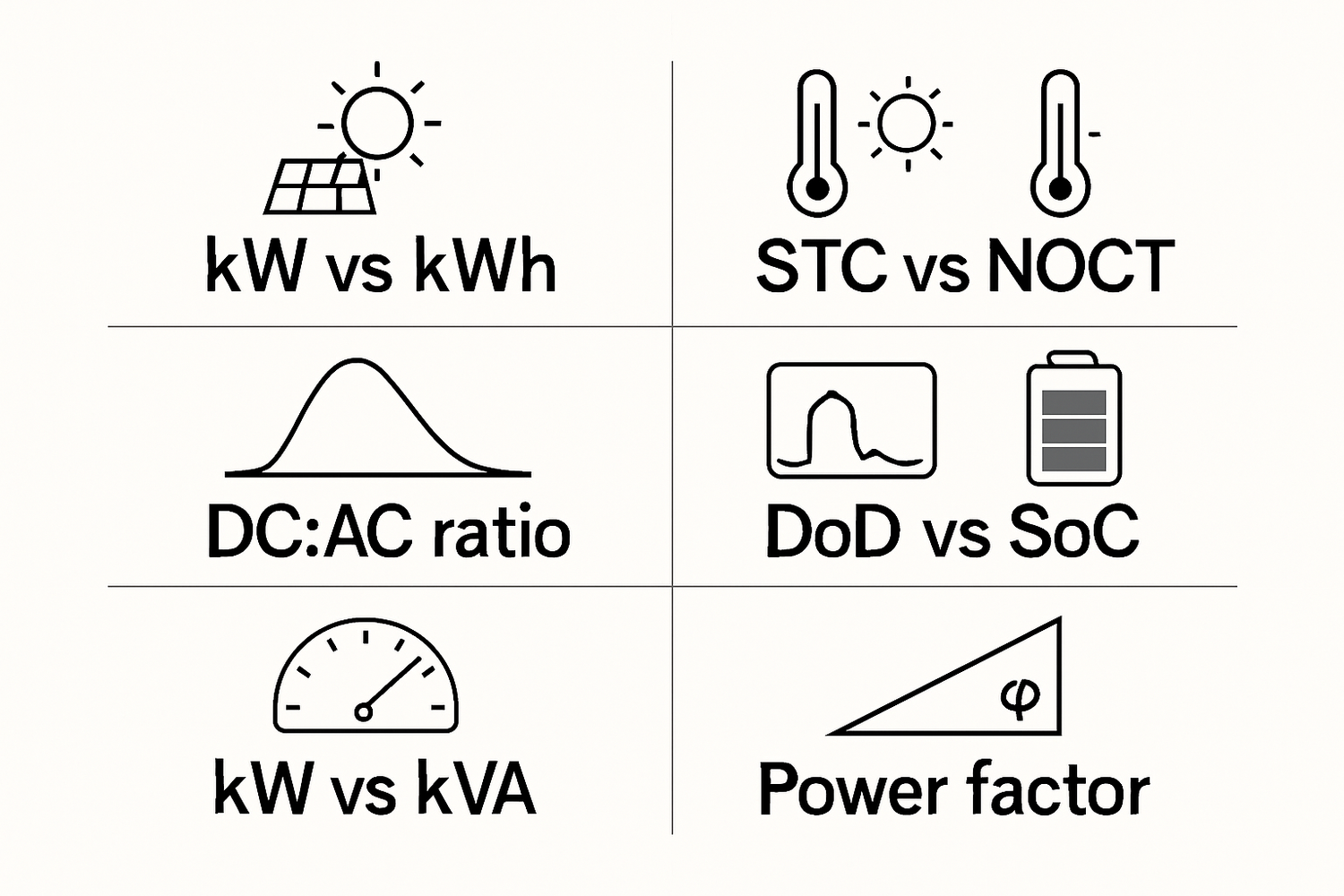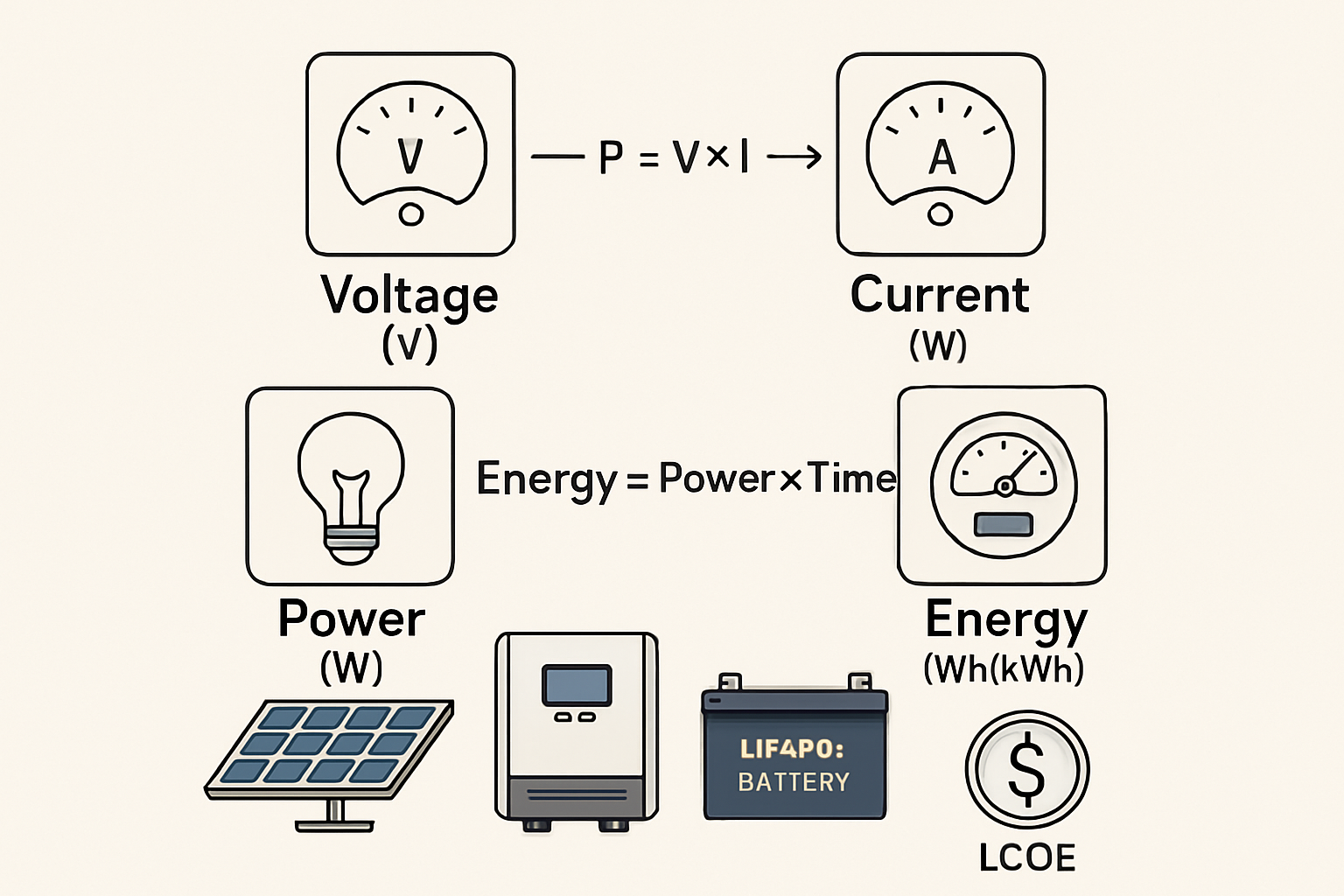Small wording gaps can trigger large cost gaps in a solar purchase. This piece lists nine frequent solar terminology mistakes, shows quick checks to avoid them, and adds data-backed context from global energy agencies. You get practical tips you can apply to proposals and contracts right away.

1) kW vs kWh
What these units refer to
kW is power (rate at a moment). kWh is energy (amount over time). A 5 kW inverter cannot output more than 5 kW at any instant, yet the system can produce 20–30 kWh across a sunny day.
Common pitfall
Comparing a panel’s kW rating to your monthly kWh bill as if they were the same metric.
Quick check
- Daily energy estimate ≈ System DC kW × 3–6 kWh/kW-day, depending on location and season.
- Yearly energy ≈ DC kW × local specific yield (1,100–1,800 kWh/kW-year in many markets).
What to ask
Ask for expected monthly kWh by season, not only the system kW size.
2) STC vs NOCT ratings
What they are
STC is a lab rating at 1,000 W/m² irradiance and 25°C cell temperature. NOCT represents a more realistic test: ~800 W/m², 20°C ambient, 1 m/s wind, open rack; cell temperature ~45°C.
Common pitfall
Using STC nameplate as your real output expectation. Panels run hotter and produce less in the field.
Quick check
- Expect 10–25% lower peak power at NOCT vs STC.
- Check the module’s datasheet for both STC and NOCT power to set your expectations.
Authority context
An Energy.gov solar page notes that module ratings reflect lab conditions; real output varies with temperature and irradiance.
3) DC rating vs AC output (and inverter clipping)
What it is
The array has a DC size (kWdc). The inverter has an AC limit (kWac). A DC:AC ratio (inverter loading ratio, ILR) of 1.1–1.4 is common to boost morning/afternoon harvest.
Common pitfall
Assuming a 7 kWdc array will deliver 7 kWac to the home. During bright, cool hours, the DC may exceed the inverter limit, leading to clipping.
Case check
Example: 6.0 kWdc with a 5.0 kWac inverter (ILR 1.2). On perfect peaks, 0.5–1.0 kW may clip for a short window. Annual energy still rises due to better shoulders.
Authority context
An IEA energy investment report (2023) highlights module price swings and financing shifts that push designers to optimize ILR for the best cost per kWh, not only the highest peak.
4) Panel efficiency vs system capacity factor
What they are
Panel efficiency (e.g., 20%) is cell-to-electric conversion at set conditions. Capacity factor is yearly energy divided by the nameplate times hours in a year.
Common pitfall
Reading a 22% panel efficiency and expecting a 22% capacity factor. Many rooftop systems land near 12–22% capacity factor based on location, shading, tilt, and losses.
Quick check
- Capacity factor ≈ Annual kWh / (kWdc × 8,760).
- A higher-efficiency module helps on limited roof area, yet shading and orientation can dominate.
Authority context
The IRENA knowledge hub emphasizes that real production depends on local solar resource and system design, not only panel efficiency.
5) Simple payback vs LCOE
What they are
Simple payback ignores lifespan after payback. LCOE (levelized cost of energy) spreads capital, O&M, and financing over lifetime kWh.
Common pitfall
Choosing a system based only on “years to pay back,” which can favor short-life or low-quality gear.
Authority context
Solar Energy Perspectives notes that payback is a poor decision metric; it overlooks the energy produced after payback and can mislead buyers. An IEA energy investment report (2023) adds that LCOE for PV rose in 2022 due to cost pressures, yet remained attractive versus new fossil generation in many markets.
Quick check
- Ask for LCOE, cashflow over 25 years, and O&M assumptions.
- Compare offers on cost per warranted kWh, not only sticker price.
6) DoD vs SoC in batteries
What they are
Depth of Discharge (DoD) is how much of the battery you use. State of Charge (SoC) is what remains. 80% DoD means 20% SoC left.
Common pitfall
Confusing the two and oversizing or undersizing storage. LiFePO4 chemistries often support higher DoD with long cycle life.
Quick check
- Usable energy ≈ Nominal kWh × Allowed DoD.
- For 10 kWh nominal at 90% DoD, usable ≈ 9 kWh per full cycle.
Practical note
In integrated ESS, a battery management system keeps DoD within safe limits to protect lifespan and safety.
7) Cycle life vs calendar life
What they are
Cycle life counts full charge/discharge cycles to a set retention (e.g., 70–80%). Calendar life is years until similar retention at a given temperature, even with light cycling.
Common pitfall
Buying based on a high cycle-life figure yet storing the unit in hot spaces, which accelerates aging and shortens calendar life.
Quick check
- Ask for cycle life at the stated DoD and temperature.
- Seek thermal management details and warranty terms in years and cycles.
Authority context
The IEA energy investment analysis (2023) notes that financing conditions and costs shift over time; robust warranties and clear performance metrics help de-risk storage investments.
8) Net metering vs export tariffs (and TOU)
What they are
Net metering often credits exported kWh at retail, while export tariffs can pay less than retail. Time-of-Use (TOU) rates vary by hour.
Common pitfall
Assuming a 1:1 retail credit for exports. Many markets have partial credit or TOU schedules that change value by time.
Quick check
- Ask your utility to spell out export rate, TOU windows, and fixed charges.
- Storage can shift exports to higher-value windows, raising self-consumption.
Authority context
The U.S. EIA and Energy.gov note that policy design and rate structures shape solar economics. Always verify your local tariff.
9) kW vs kVA and power factor
What they are
Some inverters list kVA. Real power kW = kVA × power factor (PF). At PF 0.8 and 5 kVA, real power is 4 kW.
Common pitfall
Comparing a 5 kVA inverter to a 5 kW inverter as if identical. They are not unless PF = 1.
Quick check
- Check continuous kW rating at your target PF.
- Confirm surge kVA and duration for starting motors and pumps.
Quick reference table
| Term pair | Correct usage | Rule of thumb |
|---|---|---|
| kW vs kWh | kW is power; kWh is energy | Daily kWh ≈ kWdc × 3–6 |
| STC vs NOCT | Lab rating vs realistic field condition | NOCT peak often 10–25% below STC |
| DC vs AC (clipping) | DC:AC ratio ~1.1–1.4 is common | Small clipping can raise yearly kWh |
| Efficiency vs capacity factor | Module spec vs annual yield metric | Typical CF ~12–22% for rooftops |
| Payback vs LCOE | Simple years vs cost per lifetime kWh | Use LCOE for fair offer comparisons |
| DoD vs SoC | Used vs remaining charge | Usable kWh = Nominal × DoD |
| Cycle vs calendar life | Cycles to retention vs years to retention | Heat shortens both |
| Net metering vs export tariff | Retail credit vs set export price | Check TOU windows |
| kW vs kVA | kW = kVA × PF | Verify kW at PF 0.8–1.0 |
Policy and market signals that affect terms
An IEA energy investment analysis (2023) reports that solar led new generation investment, while module prices rose about 20% year-on-year in early 2022 and began easing in early 2023 as manufacturing expanded. The same report flags permitting delays and grid bottlenecks that affect project timelines and cost assumptions. A separate IEA update notes the EU’s provisional target for at least 42.5% renewables by 2030, alongside efforts to speed permitting queues. These shifts show why contract language on timelines, interconnection, and price adjustments matters.
Solar Energy Perspectives also warns against overreliance on payback metrics; lifecycle thinking aligns better with durable gear, such as LiFePO4 storage and hybrid inverters integrated in modern ESS.
Real-world sizing tips
- Roof-first sizing: If roof is tight, higher-efficiency modules can raise kWdc per square meter, but still validate shading and tilt first.
- Inverter ratio: For most homes, a 1.2–1.3 DC:AC ratio balances clipping and cost. Verify with your installer’s energy model.
- Storage right-sizing: Start with critical loads (Wi‑Fi, lighting, refrigeration, select outlets). Translate to kWh per outage and peak kW needed, then map to DoD and cycles.
- Thermal care: Keep batteries in cool, dry spaces to support both cycle and calendar life.
Case snapshot
A home uses 900 kWh/month. Proposal A: 7.2 kWdc, 6 kWac inverter, south-facing, estimated 10,800 kWh/year (capacity factor ≈ 17%). Storage: 10 kWh LiFePO4 at 90% DoD. Usable battery energy ≈ 9 kWh. With TOU rates and partial export credit, shifting 6 kWh/day from late afternoon to evening can cut bills more than adding another 0.8 kWdc of panels. Clear terms on DC vs AC rating, DoD, TOU, and export price help the buyer decide.
Key takeaways
- Match units to decisions: kW for peak power, kWh for bills, LCOE for long-term value.
- Expect NOCT, not STC, in daily life. Model DC:AC ratio and clipping.
- Clarify battery DoD/SoC, cycle vs calendar life, and thermal limits in the warranty.
- Read tariffs: export rates, TOU, and fixed charges reshape savings math.
FAQ
How much does inverter clipping reduce energy?
With a DC:AC ratio near 1.2–1.3, clipping usually trims only short peak windows. Annual losses are modest and often offset by higher morning and afternoon harvest.
Does higher module efficiency always raise savings?
It helps on tight roofs. Yet azimuth, tilt, shading, and tariff design often drive savings more than a few efficiency points.
What’s a good DoD for LiFePO4?
Many systems run 80–90% DoD while maintaining strong cycle life. Check the specific warranty terms and thermal guidance.
Are payback years enough for decision-making?
No. Payback omits energy produced after payback. LCOE, warranty-backed kWh, and O&M provide a clearer view. See Solar Energy Perspectives for a deeper discussion.
Why do policy shifts affect solar terms?
Rate design, export credit, and permitting shape project cost and value. IEA’s 2023 investment analysis describes price and permitting trends that influence real projects.
Important notice
Non-legal advice. Energy tariffs, incentives, and interconnection rules vary by region and change over time. Confirm details with your utility, local authority, and a qualified installer.





Leave a comment
All comments are moderated before being published.
This site is protected by hCaptcha and the hCaptcha Privacy Policy and Terms of Service apply.